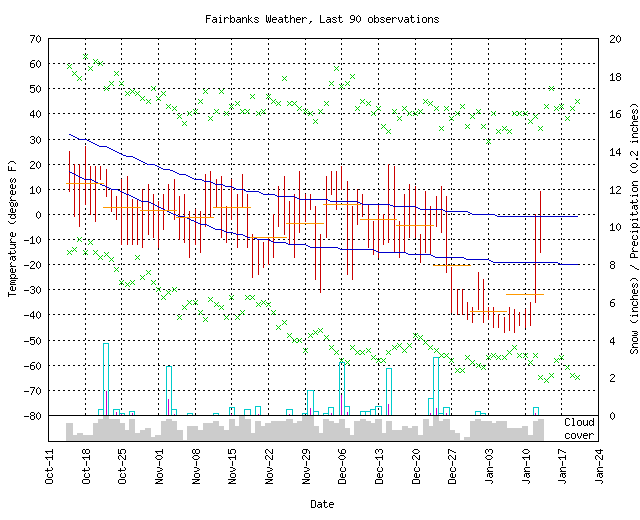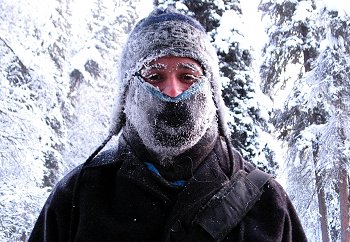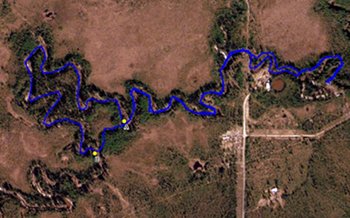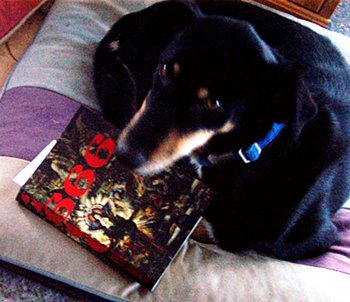The cold snap of 2008/2009 has finally broken. The plot below comes from my Ninety day weather summary plot for the Fairbanks Airport weather station (PAFA). That web page has a description of all the variables shown on the plot, but here I’m interested in the vertical red bars, which represent the high and low temperatures for the day. You’ll notice that from December 27th through January 11th, the temperature was far below normal (the 30-year normal high and low temperature are the solid blue, mostly horizontal lines. Record high and low temperatures are the green x marks. We didn’t come close to breaking any low temperature records.

Ninety day weather summary
So how does this cold snap compare to those in the past? Most people cite the cold snap of 1989 as the one they remember. Was the current period comparable?
My first attempt at answering this question was to generate a list of consecutive days where the low temperature for the day was below -40. It’s a fairly complex query because we need to compare a table against itself, and we need to report the results from both rows that match. Here’s the SQL:
SELECT a.dt, a.min_temp, a.temp, a.max_temp
FROM isd_daily AS a INNER JOIN isd_daily AS b
ON a.isd_id=b.isd_id AND a.dt=b.dt - INTERVAL ’1 DAY’
WHERE a.isd_id=’702610-26411’ AND a.min_temp<=-40 AND b.min_temp<=-40
UNION
SELECT b.dt, b.min_temp, b.temp, b.max_temp
FROM isd_daily AS b INNER JOIN isd_daily AS a
ON a.isd_id=b.isd_id AND a.dt=b.dt - INTERVAL ’1 DAY’
WHERE b.isd_id=’702610-26411’ AND a.min_temp<=-40 AND b.min_temp<=-40
ORDER BY DT
The output is a list of consecutive dates and temperatures. From there, I wrote a Python script to read these periods and calculate the length, average temperature, average minimum, and the cumulative degree days below freezing. Using this metric, our recent cold snap was the coldest since the cold snap of 1989. Here are the two compared:
For period between 1989-01-19 and 1989-02-01 Days = 14 Average temp = -42.9 Average minimum = -48.0 Cumulative degrees below freezing = 1048.7 For period between 2009-01-02 and 2009-01-11 Days = 10 Average temp = -40.8 Average minimum = -44.8 Cumulative degrees below freezing = 728.0
You can see that this doesn’t include the first portion of the cold snap, because the low temperature on New Year’s Day was a balmy -38°F. So it doesn’t seem like it really captures the full length of the recent event.

Getting the mail at -53°F
The other approach I tried was to examine the entire historical record, calculating the average temperature for all periods of various lengths. It turned out that a window of 16 days resulted in the highest ranking. But even so, it was the 62nd coldest 16 day period between 1946 and the present. You can see the reason why the ranking is so low if you look at the results:
rank Date interval avg temp (°F) 1 1947-01-17 - 1947-02-01 -47.19 2 1947-01-18 - 1947-02-02 -47.06 3 1947-01-19 - 1947-02-03 -46.84 4 1947-01-16 - 1947-01-31 -46.82 29 1989-01-17 - 1989-02-01 -41.43 30 1989-01-18 - 1989-02-02 -41.27 32 1989-01-16 - 1989-01-31 -40.96 35 1989-01-19 - 1989-02-03 -40.58 47 1989-01-20 - 1989-02-04 -39.56 48 1989-01-15 - 1989-01-30 -39.53 62 2008-12-27 - 2009-01-11 -38.07
The top four coldest 16-day periods were all part of the same, longer cold snap, that lasted from January 16, 1947 through February 3rd of that year. Because the entire period was so cold, it yielded the top four coldest 16-day periods. I also included the intervening 1989 cold periods for reference. You can see that the 1989 event was also much longer than the 14-day interval identified by the consecutive days below -40 technique. The average temperatures over the 1947 events are quite impressive when compared to the recent average and the 1989 event. As bad as it seemed, we don’t really have much too complain about.

Bookshelf
> books_per_foot = c(14,11,17,11,10,18,12,12,
13,16,15,14,13,14,15,8,10,10,11,11)
> summary(books_per_foot)
Min. 1st Qu. Median Mean 3rd Qu. Max.
8.00 11.00 12.50 12.75 14.25 18.00
> mean(books_per_foot)
[1] 12.75
> sd(books_per_foot)
[1] 2.613225
With that information (12.75 books per foot of shelf space with a standard deviation of 2.61 books) and the total length of each bookshelf, it ought to be relatively easy to extract a listing of what books to put on each bookshelf.
Actually moving them will be more of a challenge!

Heat gun, vent pipe
Last winter our vent pipe froze solid and I spent a couple hours in the attic with a heat gun melting the blockage. A couple days ago I noticed that flushing the toilet was pulling water out of the traps in the sink and bathtub, so I knew the vent was getting plugged again. My attempt at a fix over the summer was to put a larger pipe over the vent on the roof so the condensation might happen in the outer pipe, which could be easily removed and cleaned out. Unfortunately, when I got up on the roof today, not only was it impossible to get the outer pipe free, but the growing constriction wasn’t in the outer pipe anyway. Mid-summer my neighbor suggested replacing the section of the vent in the attic with a much larger diameter pipe (6” was his suggestion) and then insulating it. I never got around to it; almost frozen vent pipe; a priori.
The total freezing degree days to this point in the winter season has been 2,258,† which ought to give me a pretty good way of estimating when I’ll have another problem. Thus far we’ve had 74 days with an average daily temperature below freezing, and the average temperature for those days was 1.4°F. That’s below normal for the year: nine of the last eleven weeks have been below average. But the heart of the winter is approaching, so it’ll take many fewer than 74 days to double our freezing degree days for the season.
My first attempt to fix the clog was to insert a heat gun into the clean out and let the warm air from the heat gun melt it (shown in the photo). I don’t think this had any real effect. I kept it going for a little over an hour, monitoring the backside of the pipe to make sure the heat gun wasn’t melting it. But it was around -10°F this morning, so I’ll bet the hot air was pretty cold by the time it rose to the ice. The second attempt was using a pipe snake from up on the roof, but it couldn’t go past the constriction, and even if it had, I’m not sure it really would have cleared out much ice. Finally, I dragged a five gallon bucket filled with hot water up onto the roof. I got about three gallons into the vent before it was filled to the top. At first I was nervous that this wasn’t going to work and I’d have three gallons of water turning to ice in the vent, but the water started dropping slowly, and after a minute, the blockage gave way and hot water came plunging down the pipe. I poured the final gallon or two through the pipe, and came down off the roof.
Tomorrow I’ll put some 2” fiberglass insulation around the part of the pipe that’s exposed in the attic, which should help. And I’ll be keeping my eye on the total freezing degree days for the rest of the winter. Once it gets up to 4,000, I may want to go back up on the roof with another bucket of hot water.
†SQL query from my weather database: SELECT sum(32.0 - t_avg::double precision) FROM daily;I just got back from walking Nika and Piper on the Creek. I’d looked at my GPS track from yesterday’s walk on the Creek and saw an obvious shortcut (from point A to B on the map) to cut off some distance. My objective was to take the Creek out to a section line (at points D and E—click on the image to see a full size version) that I also saw from the satellite imagery for the area, and wanted a way to make the route shorter. Yesterday’s walk was more than five miles, even though a raven could have covered the distance in a little over a half mile.
We walked down the Creek, came to the start of the shortcut at point A, walked overland through the forest to point B back on the Creek, and I immediately turned the wrong direction. I’d already walked about halfway back to point A before I realized I went the wrong way. Next time, turn left!
It is amazing how disorienting the Creek is, even with a GPS. Because it winds back and forth so much, even if you know where you’re going and can see it on the little map your GPS is showing you, it’s really difficult to tell if you are getting closer to your objective. The good thing is that the Creek only goes two ways. If you went the wrong way, just turn around and go back.
I finished Gravity’s Rainbow last week. For me, it was a bit of a disappointment, not so much with the book itself, but with myself for not devoting the time to reading it more faithfully from start to finish. With the previous Pynchon I’ve read (Crying of Lot 49, Mason & Dixon, Against the Day) I started out reading very carefully, taking notes as I went along. After I got comfortable with the narrative and felt I was familiar enough with the gestalt, I blazed through the remainder of the book. This time around, I started the same way, but didn’t devote the time to reading it after the first part and I wasn’t able to keep the characters and situations in my head. So the novel wound up as a jumble. I can see the brilliance and magic at the margins of my comprehension, but that’s about it.
At this point, I’d have to place it below both Mason & Dixon and Against the Day in my list of favorite Pynchon books. Someday I’ll have to pick it up again and try to give it the time it deserves.
Since finishing it, I’ve been reading like crazy. First was Deb Olin Unferth’s Vacation, which was fantastic. It reminded me a bit of the way Paul Auster can keep you off balance and wondering what will come next as the characters start behaving more and more strangely. Then McSweeney’s 28, which was a series of entertaining short fables (my favorite was the one about the guy who kept meeting himself). Finally, Mary Roach’s Bonk. I enjoyed this one as well, even if the continual footnoted asides became tedious by the end. I was amused, and feel like I learned a lot about what science has to say about sex.
After my success at quickly completing three books, I’ve started working on 2666 by literary superstar Roberto Bolaño. I had to special order it because my local independent bookstore didn’t have any copies, and appeared to never have heard of Bolaño. They’re surprisingly out of touch with the world of literary fiction, which seems odd for a store trying to survive the big box, low price onslaught of Barnes and Noble. Maybe they make their hay selling Twilight or whatever other bestselling doorstop is popular today and forgotten tomorrow.
In any case, 63 pages into 2666 and I’m highly amused. Thus far, the story has revolved around four literary critics obsessed with a reclusive German author. If that sounds like an odd premise for a story, it is; odder still is that despite there being very little plot, I’m eager to get back to it.
More eager than chopping wood or cooking my Thanksgiving ham, stuffing, gravy and sweet potato pie, in fact.

